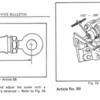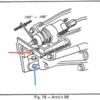My clutch engages near the top of the pedal travel, I want it much closer to the floor, can it be anything else bedsides a worn clutch? Just got the car, reads 17k miles. Shifts fine.
Also, On the slave adjustment, after I think I've got it set right, I go for a drive. when I recheck it, it seems I've lost my free play.
I would love it if somebody could do a comprehensive YouTube video on this adjustment. I've read everything there is to read and still confused. References to items that are not familiar to you do little to aid in understanding. I'm doing all my adjustments through the plunger. I don't see how that little screw and stop nut do anything.
Original Post



